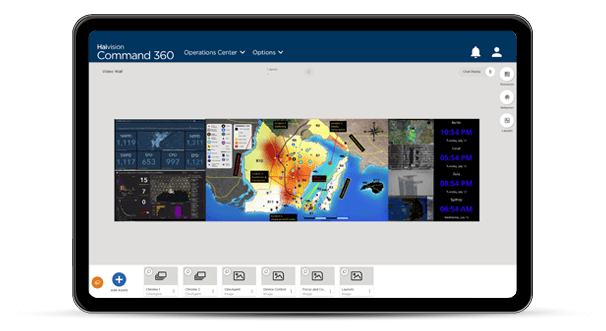Visualization systems are at the heart of public safety sector operations centers. These platforms and workstations process all critical information, resource allocation, and personnel management flow in and out to the field. Older systems built around multiple, disparate devices offer limited functionality and fail to present the cohesive and collaborative working environment that a true solution provides. When implemented correctly, an effective system is a vital component of any operations center and provides three key benefits:
The Common Operating Picture
The common operating picture presented by a dynamic visualization solution is the unified vision that operators and first responders use to inform all actions and decisions. Visual data assets, like live news feeds, IP cameras, weather mapping systems, social media, VMS, and more stream into the picture. From there operators can receive information, separate good intel from bad, recognize patterns, and relay unified instructions to first responders as they arrive at the scene of an incident.
Collaboration Across Multiple Agencies and Departments
Once a common operating picture is in place, Real Time Crime Centers, Operations Centers, 911 Call Centers, and more all become facilities that can readily share their collaborative workspace with additional agencies. For example, a local Emergency Operations Center may have their attention focused on a severe weather event when the need to coordinate with FEMA arises. The ability to quickly bring in a federal agency to work alongside local emergency operations in an environment equipped to combine all workflows effortlessly is vital.
Improving Incident Response Time Through Real-Time Data
As real-time information comes into the common operating picture from multiple sources, users can easily aggregate and organize this intel to create profiles of active scenes or key individuals. This information, broadcast across the shared picture, gives operators the verified intelligence they need to better inform officers and first responders in the field. These profiles are also shared across jurisdictions and multi-agency workflows, ensuring that everyone involved is working with the highest quality and most up-to-date information available. This helps to streamline reactive decision-making processes as much as possible.
The above points all outline the desired effect that a dynamic visualization solution presents, including the overall improvement of situational awareness around occurring incidents. This boon to the decision-making process serves to enhance officer safety as they approach active scenarios with vital, up-to-the-minute intelligence.
Haivision recently hosted a Public Safety webinar to help illustrate and detail how visualization systems can help to increase officer safety and situational awareness. Please view the saved recording below for additional details and examples from existing crime centers and emergency operations facilities.
